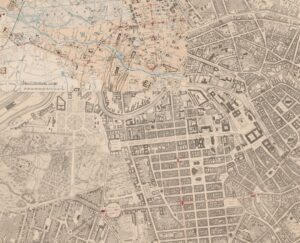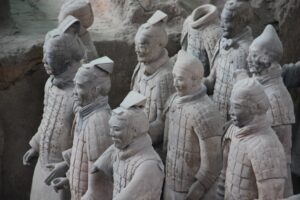The Pre-Romantic period, spanning the late 18th century, serves as a crucial bridge between the rationalism of the Enlightenment and the emotional depth of Romanticism. This era is characterized by a burgeoning interest in individual experience, nature, and the complexities of human emotion. While the Enlightenment emphasized reason, order, and scientific inquiry, the Pre-Romantics began to explore themes that would later become central to Romantic literature and art.
Figures such as William Blake, Robert Burns, and William Wordsworth emerged during this time, each contributing to a shift in cultural consciousness that valued personal sentiment over strict rationality. The Pre-Romantics were not merely a reaction against Enlightenment ideals; they were also a reflection of the changing social and political landscape of their time. The American and French Revolutions had ignited discussions about liberty, equality, and the rights of individuals, prompting writers and artists to reconsider the role of the individual in society.
This period saw a growing discontent with industrialization and urbanization, leading to a nostalgic yearning for a simpler, more pastoral existence. The Pre-Romantics laid the groundwork for the Romantic movement by emphasizing the importance of personal experience and emotional authenticity, setting the stage for a literary revolution that would redefine artistic expression.
Key Takeaways
- Pre-Romantic writers and artists laid the groundwork for the Romantic movement with their focus on emotion, imagination, and nature.
- The Enlightenment’s emphasis on reason and logic influenced Pre-Romantic thinkers to explore the emotional and imaginative aspects of human experience.
- Pre-Romantic literature and art marked a shift towards a more personal and emotional expression, breaking away from the formal and structured styles of the past.
- Nature was a central theme for Pre-Romantic writers and artists, who saw it as a source of inspiration and a reflection of the human experience.
- Emotion and imagination played a crucial role in Pre-Romantic works, setting the stage for the Romantic movement’s focus on individualism and creativity.
The Influence of the Enlightenment
The Limitations of Reason
However, as the Enlightenment progressed, it became evident that reason alone could not encapsulate the full spectrum of human experience. The Pre-Romantics emerged in response to this realization. They began to critique the limitations of Enlightenment thought by highlighting the significance of emotion and intuition.
The Rise of Pre-Romanticism
For instance, Rousseau’s concept of the “noble savage” suggested that humanity’s natural state was one of purity and goodness, which could be corrupted by civilization.
Balancing Reason and Emotion
The tension between reason and emotion became a defining characteristic of this transitional period, as artists and writers sought to balance rational thought with the complexities of human feeling.
The Shift in Literary and Artistic Expression

As Pre-Romantic thinkers began to challenge Enlightenment ideals, a notable shift occurred in literary and artistic expression. The rigid structures of neoclassicism gave way to more fluid forms that allowed for greater personal expression. Poets like William Blake rejected conventional poetic forms in favor of innovative styles that conveyed their unique visions.
Blake’s “Songs of Innocence and of Experience” exemplifies this shift; through contrasting poems, he explored themes of childhood innocence alongside the harsh realities of adult life.
M.W. Turner began to move away from classical themes and instead focused on capturing the sublime beauty of nature.
Turner’s use of light and color conveyed emotional depth and a sense of movement that resonated with viewers on a visceral level. This departure from traditional artistic conventions marked a significant evolution in how artists approached their work. The emphasis on individual perspective and emotional resonance became hallmarks of Pre-Romantic expression, paving the way for the more overtly emotional works that would characterize the Romantic movement.
Nature as a Source of Inspiration
Nature emerged as a central theme during the Pre-Romantic period, serving as both a backdrop for artistic expression and a source of profound inspiration. The natural world was increasingly viewed not just as a setting but as a living entity imbued with spiritual significance. Poets like William Wordsworth celebrated nature’s beauty and its ability to evoke deep emotional responses.
In his poem “Lines Composed a Few Miles Above Tintern Abbey,” Wordsworth reflects on his connection to nature and how it shapes his understanding of life and self. This reverence for nature was also evident in the works of painters like Caspar David Friedrich, whose landscapes often depicted solitary figures contemplating vast natural vistas. Friedrich’s paintings evoke feelings of introspection and transcendence, inviting viewers to engage with their own emotions in relation to the natural world.
The Pre-Romantics’ fascination with nature was not merely aesthetic; it represented a longing for authenticity and a desire to reconnect with something pure and untainted by industrialization. This connection would later become a defining characteristic of Romanticism, where nature was often portrayed as a source of inspiration and spiritual renewal.
The Role of Emotion and Imagination
The Pre-Romantic period marked a significant shift in how emotion and imagination were perceived within literature and art. While Enlightenment thinkers prioritized reason and logic, Pre-Romantic writers began to assert that human experience was deeply rooted in feelings and subjective perception. This emphasis on emotion allowed for a richer exploration of the human condition, as writers sought to capture the complexities of love, loss, joy, and despair.
For example, Robert Burns’s poetry often reflects an intimate connection to personal experience and emotion. His poem “A Red, Red Rose” expresses profound love through vivid imagery and heartfelt sentiment. Similarly, Blake’s work frequently delves into themes of innocence, experience, and spiritual awakening, showcasing how imagination can transcend rational thought.
The Pre-Romantics understood that imagination was not merely a tool for creativity but also a means of understanding oneself and one’s place in the world. This focus on emotional depth would become a cornerstone of Romantic literature, where the exploration of inner life took center stage.
Impact on the Romantic Movement

The Pre-Romantic period laid essential groundwork for the subsequent Romantic movement by challenging established norms and embracing new ways of thinking about art and literature. The emphasis on individual experience, emotional authenticity, and a deep connection to nature became defining characteristics of Romanticism. Writers such as Lord Byron, John Keats, and Percy Bysshe Shelley drew inspiration from their Pre-Romantic predecessors while further developing these themes into more expansive narratives.
Romanticism took the ideas introduced by Pre-Romantics and amplified them, leading to an even greater focus on personal expression and emotional intensity. The notion that art should reflect individual experience became central to Romantic literature; poets often wrote from deeply personal perspectives that resonated with readers on an emotional level. Additionally, the Romantic idealization of nature as both beautiful and sublime can be traced back to Pre-Romantic influences that celebrated its power to evoke profound feelings.
In conclusion, while the Pre-Romantic period may be seen as a transitional phase between Enlightenment rationality and Romantic emotionality, its impact on literature and art is undeniable. By embracing emotion, imagination, and nature as sources of inspiration, Pre-Romantic thinkers set the stage for a cultural movement that would redefine artistic expression for generations to come. The legacy of this era continues to resonate today as we explore the intricate relationship between human experience and creative expression.
If you are interested in exploring the beauty of nature and the importance of change, you may also enjoy reading about






















+ There are no comments
Add yours